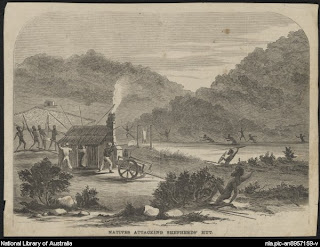The gold rushes of 19th century Australia were one of the catalysts which helped transform the fledgeling colony into a new nation. However they also gave birth to many anxieties within the community.
One obvious anxiety generated by the gold rush was the tremendous increase in migration. In the ten year period between 1851 and 1861 migration by sea into Victoria was something in order of 290,000i. Of this, a significant portion were Chinese, who by 1861 represented approximately one quarter of all miners on Victorian goldfields. The attitudes of the community towards this new wave of 'foreign' immigration could be described as ranging from cautious to openly hostile, and anything in between. The Lambing Flat riots are one example of this anxiety boiling over, as a large mob assembled and terrorised the Chinese camp. Aside from the barbarism of the riot itself, the fact that the Chinese miners were seperated into their own, seperate enclave is an example in itself of the anxiety which the gold rush inspired migration caused.
Chinese miner in traditional garb relaxing with a long stemmed pipe, Daintree, Richard, 1832-1878
http://www.pictureaustralia.org/apps/pictureaustralia?action=PADisplay&mode=display&rs=resultset-3723521&no=2
Another key anxiety which grew out of the gold rushes was the concern over land rights which eventually led to land reforms. Although it is a popular view brought about by the pioneer myth that it was early settlers who subdued and unlocked the landscape for all Australians, it can be argued that it was the land reforms which followed the gold rushes which truly unlocked the land by easing, if not breaking, the monopoly on land held by the established wealthy.
iFahey, Charles, 'Gold and Land' in in Gare, Deborah, Ritter David Making Australian History: Perspectives on the Past Since 1788, Cengage Learning (Sydney 2008) p. 207




